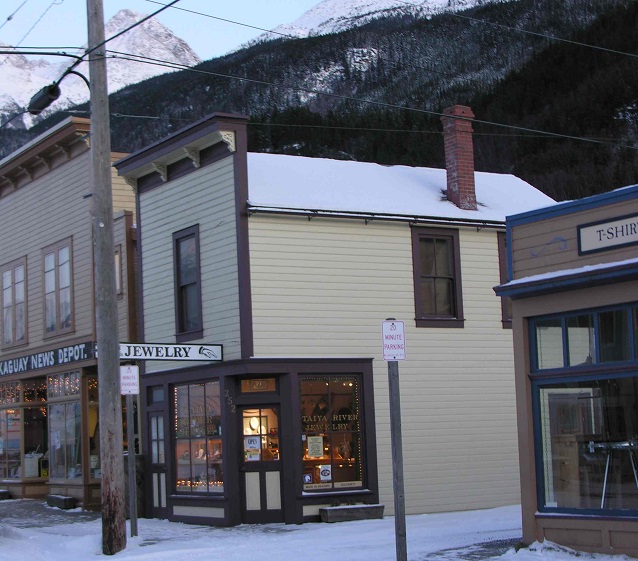
NPS photo
Klondike Gold Rush National Historical Park owns a number of historic buildings within the Skagway Historic District. Most of these buildings have been fully restored and leased out to private citizens for their businesses or are used by the park for exhibits or office space. Before the National Park Service (NPS) actually starts restoring an historic building, a lot of preliminary work have to be done in order to insure the historical accuracy of the restoration. Historical architects carefully examine and document each building in order to assess its current condition and determine what needs to be done to the structure to insure its continued long term survival. Historical archeologists excavate under or around the building in order to preserve the archeological record that would be damaged or destroyed by the actual building restoration process with the construction of foundations, utility lines and the like and to get a better understanding of what life was like in historic Skagway that was not mentioned in the history books. Last but not least, historians research the history of the building itself in order to, among other things, determine the building’s period of significance, or the time period the building should be restored to, and to insure that the restoration is historically accurate. Historians also dig into the history of the people that built and operated these buildings, at least during the gold rush era, and try to tell their stories.
One of these buildings, acquired by the park in late February 1978, is Frédérick Verbauwhede’s Cigar Store and Confectionery. Located at 252 Broadway, it is on the east side of Broadway between Second and Third Avenues, just north of the alleyway that divides the block. Research on the history of this building was considered complete in 1983 and the building was restored to its 1899 to 1904 period of significance in 1986. It has been rented to the private sector ever since.

Photo courtesy of Historic American Buildings Survey
A few years back, however, Roger Verbauwhede, grandson of the original owner of the building, Frédérick Verbauwhede, contacted Karl Gurke, our park historian, through email from Belgium, beginning a delightful conversation about his grandfather’s adventures in America, Alaska and during the great Klondike Gold Rush. What follows combines the history uncovered by park service historians years ago and the family stories that were told to Roger when he was a young boy in Belgium listening to his grandfather regale him with tales of Native Americans, bears, gold, robberies, and Alaska.
Frédérick Verbauwhede, born on February 1850, came from the city of Waregem in Flandre, Belgium. Flandre today normally refers to the Dutch speaking northern portion of Belgium. Historically, the name referred to a region located in the north-western part of present-day Belgium and adjacent parts of France and the Netherlands. Waregem is located about 31 miles (50 kilometres) northeast of the French city of Lille. In 1871, when he was 21, Frédérick left the family farm. By 1878 he was a sailor on the steamer Rotterdam which travelled between the cities of Rotterdam in the Netherlands and New York City. It was at this time that Frédérick started to dream about America. On May 21, 1880, he married Nathalie Van Leyseele in Avelghem, Belgium. Nathalie had been born on January 4, 1851 and had a brother living in Philadelphia, Pennsylvania at the time of her marriage. In 1889 Frédérick and Nathalie immigrated to Philadelphia, where, after many jobs, Frédérick became a member of the Philadelphia mounted police. His grandson, Roger, still has Frédérick’s badge labelled “Special 9 Police” and his gun from that time period.

Map Service Layer Credits: National Geographic, Esri, DeLorne, HERE, UNEP-WCMC, USGS, NASA, ESA, METI, NRCAN, GEBCO, NOAA, increment P Corp.
Both Frédérick and Nathalie became naturalised American citizens in 1890. They had three children: (1) Sadie (Sidonie) Marie born July 9, 1890 in Philadelphia and died November 1933 in Belgium. (2) Alfred, born January 8, 1892 also in Philadelphia. He became a clock and watchmaker in New York and died there on December 26, 1931, and (3) Henry, born March 24, 1894 in San Francisco, immigrated to Europe and became a dental-surgeon in Roubaix, France (close to Lille). He was imprisoned by the Germans during World War II but survived the war and died in Deauville, in north western France on January 29, 1967.
In 1894 the Verbauwhede family moved to San Francisco, California and Frédérick started working in a gold-mine. When word filtered out of the vast quantities of gold in the Klondike, Frédérick like many others caught gold fever and headed north. He arrived in Skagway, Alaska in February 1898. Apparently he acquired an important gold claim near Skagway but drunk one night, he sold it at a very low price shortly afterwards. Little gold has been found in the Skagway area so his depression at this act might be due to the fact that the White Pass & Yukon Route railway apparently bought the claim shortly after he had sold it. He soon realized, however, that merchants earned much more than gold-prospectors and being in a trade was a lot easier than hiking over the Chilkoot or White Pass trails and digging for gold in the permafrost of the Klondike. Therefore, soon after his arrival, Frédérick opened up a cigar store in the red-light district part of town known as "French Alley."
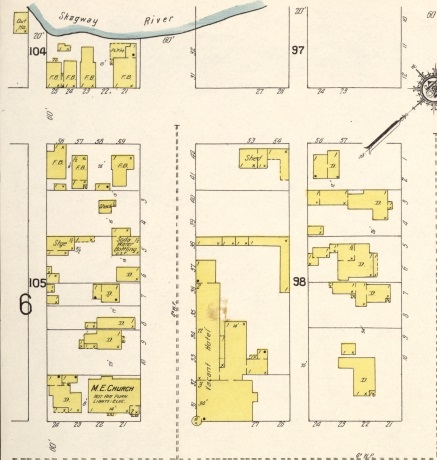
Map courtesy of Sanborn Fire Insurance Maps, 1914
Originally prostitutes were found all over Skagway but by 1898 the city council had tried to confine them to the alleyway that ran between 5th and 6th Avenues. “Paradise Alley” was the first part of this red light district running in the alleyway from Broadway west. “French Alley” was the second part of this same alleyway running from approximately mid-alley west to State Street. “Jap Alley” also known as “Yokohama Row,” was located on the east end (toward State Street) of the same alleyway but between State and Main streets. The names of the alleyways were apparently related to the nationalities of the women who worked in the alleyways. There was also a “Limerick Alley” located between 4th and 5th Avenues and between Broadway and State Streets but this name derives from a contest put on by the owner of the Board of Trade Saloon in 1908 and had nothing to do with prostitutes. In 1901 the prostitutes were relocated to 7th Avenue, which became the new “Paradise Alley.” In 1909 the cribs and parlors along 7th Avenue were moved to Alaska Street between 4th and 5th Avenues. This became a true “Restricted District” as photographs indicate that it had a fence around it that extended into Alaska Street. In 1917, Skagway’s Red Light District was officially closed by the U.S. Marshal’s office.
The Verbauwhede family soon followed Frédérick and arrived in Skagway in May 1898. As the stampede waned and business shifted toward the White Pass & Yukon Route railroad depot on southeast corner of Second Avenue and Broadway, Mr. Verbauwhede bought a thirteen-foot wide lot on Broadway on September 11, 1899 and erected a two-story false fronted, wood framed building shortly thereafter.
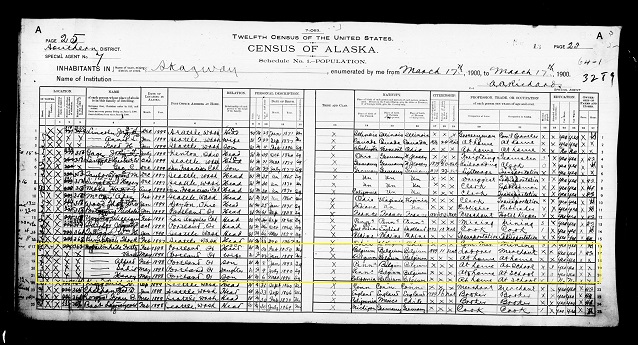
Image courtesy of 1900 United States Census
From the first floor of the new building Frédérick (Fritz according to the 1900 census) along with his wife Nathalie (Vantie according to the 1900 census) sold a large selection of cigars, tobaccos, and cigarettes as well as confections such as candy, nuts, and fruits. Apparently they also sold equipment for trappers. Among his customers were Native Americans who often traded pelts in exchange for ammunitions, food tins, and alcohol. Frédérick weighed the gold he received from gold-miners while his wife Nathalie sold candy to the town’s children. Upstairs were furnished rooms rented to transient lodgers (sometimes for just an hour). The 1900 census lists six lodgers; a traveling salesman, two brokers, a miner, a sailor, and a cook, which is a lot of people to squeeze into such a small building, especially if you add in the five members of the Verbauwhede family as well. In 1902, Mr. Verbauwhede moved his two one-story structures (cribs) from “French Alley” down to his store on Broadway. The crib closest to the store served as the residence for the family while the other crib was also rented out to lodgers.

NPS Photo
Roger Verbauwhede related one interesting story of a robbery attempt at the store: a bandit wanting the cash-box came into the store and threatened Frédérick with a gun. Nathalie from her kitchen in the back quickly realized the situation and had the presence of mind to take a cast-iron lid from the top of the stove and throw it at the robber with all her strength. She had a deadly aim and the gun dropped to the floor as the lid broke the robber’s arm. It was then easy for Frédérick to overcome the man, while Nathalie roused the neighbors. When the police arrived they congratulated her for the robber was considerate very dangerous and did not hesitate to shoot when in a fight. This was not the first time the store was broken into. In the summer of 1901 $800 was taken from the till. Then in January 1902, another thief broke in but this time left some blood on a broken window glass. The Daily Alaskan of January 7, 1902 notes that after the burglary:
"… a search for cut fingers among the suspicious characters of the town was instituted … Barney Burns … was found in his cabin, between the wharves, at the foot of State street, and immediately herded to the government bastille by the federal marshal and the municipal watchman. Barney claims his digits were gashed when the [steamer] Dolphin cleared a week ago, but medical authorities aver that the gore on his pants, shirt, coat, and towel, is freshly shed and that the cuts to his fingers are very recent. Night Watchman Hartman has been doing considerable sleuthing in the case and will not impart all the clues he has run down to convict Barney of the crime."
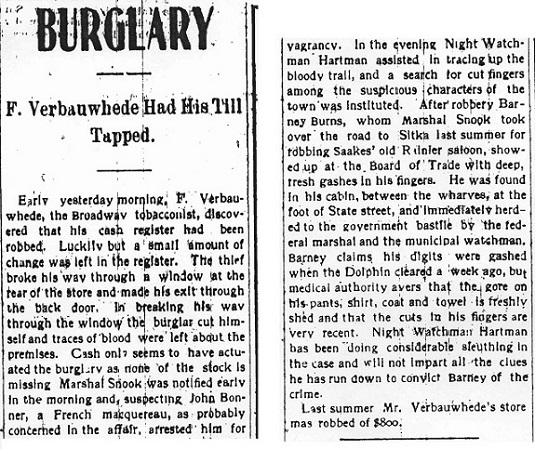
Daily Alaskan, January 7, 1902
As an old man in Belgium, Frédérick used to tell his grandson that at night, bears would come down into town from the surrounding mountains in order to rummage through the garbage cans. Some of the bears reached 6½ feet (2 meters) tall and were very frightening. Women and children were forbidden to go out at night and men were always armed. Several times Frédérick found himself face to face with one of these bears, however, they were inclined to flee but accidents did happen. He also related that at certain times of the year, harpoon fishing for salmon was great entertainment for young and old alike. Ice-skating was also popular in the winter and many matches were organized and Frédérick successfully took part in these. Several early photographs of Skagway taken from the eastern hillside show what appears to be an ice rink directly across the street from the Verbauwhede store, where the Golden North Hotel is now located. Frédérick was also a member of the Arctic Brotherhood and the family still has the gold AB pan pin as proof of membership.
On September 14, 1904 the Verbauwhedes sold their store to James D. Steinebaugh, owner of the Principal Barber Shop near Fifth and Broadway, for $800.00 and went back to San Francisco. The Principal Barber Shop, by the way, also still stands. In 1906 Frédérick Verbauwhede, his wife and all of the family, homesick for Europe, went back to Belgium and then to France. In 1931, for medical reasons Nathalie entered a retirement home and Frédérick moved in with his son, Henry, where he died on November 12, 1933 with Nathalie following him the same year.
James D. Steinebaugh bought the former Verbauwhede building for summer rental space. He had been born in April 1862 in Indiana of Indiana parents. He arrived in Skagway in October 1897 and during the time he spent in Skagway was always a barber. Exactly who rented the former Verbauwhede building between 1904 and 1910 is unknown, however, in May of 1911, Emil Richter opened a jewelry and curio shop in the building. Two years later, Richter moved into a larger building a short distance down Broadway and closer to the waterfront where Richter’s Curio is today. The former Verbauwhede store may have been vacant from then until July 1, 1916, when Steinebaugh sold the building to a gunsmith, James F. Greene. Incidentally Michael Steinebaugh, a descendent of James Steinebaugh recently donated a very nice collection of historic images of Skagway during this time period to the park. Many of the images were of excellent quality and had not been seen by park staff before. In addition to his gunsmith business, James F. Greene advertised himself as an outfitter, guide, handyman, and second hand dealer. He had been born in 1846 in England of Irish parents and passed away on January 24, 1924. His heirs sold the shop to Frank Suffecool in 1925. Mr. Suffecool opened the Alaska Transfer Company, an express delivery and taxi service, and ran the business for almost two decades. Mr. Suffecool had been born in 1864 in Illinois of parents born in Pennsylvania and Illinois and died in Skagway January 2, 1940.
In 1944, Kenneth and Christine Lamoreux and William and Dorothy Dewer purchased the building and business and continued to run the Alaska Transfer Company out of it. By this time, the store had undergone some changes in appearance and the new owners changed the building further. Most notably, a gas pump was installed in front of the structure. The families lived behind their store and emphasized gasoline sales for another ten years. In the next eleven years, the half dozen owners of the building continued to emphasize gas sales. Malcolm Moe purchased the building in 1965 and added liquor as a sales item. He later moved his Alaska Liquor Store down to the corner of Second and Broadway. In 1973 after Moe had moved, Atlas Travel rented the store until 1977.
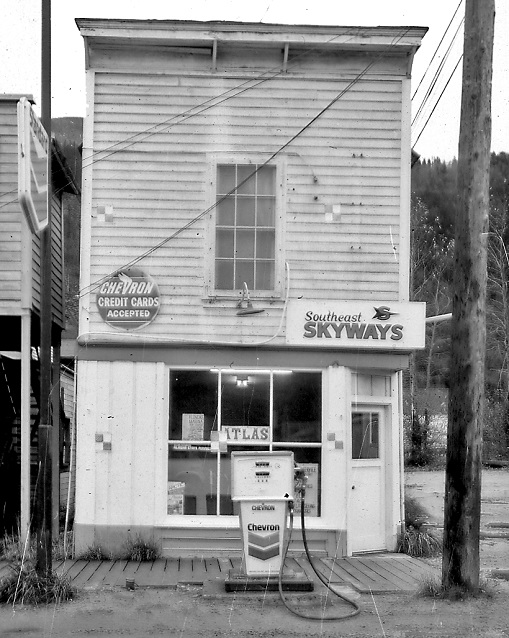
NPS Photo
The NPS acquired the Verbauwhede's Cigar Store and Confectionery building and the cribs behind it for $30,000 in 1977. Stabilization and restoration efforts were started in April 1985 and completed in November 1986 at a cost of $350,000, which included the two cribs. The exterior of the building has been restored to its 1899 to 1904 appearance with the interior adapted for contemporary use. The building is still in its original location on the east side of Broadway next to the alleyway between Second and Third Avenues (Block 35, Lot 6). The building is currently part of the Historic Property Leasing Program at Klondike Gold Rush National Historical Park and is a contributing element to the Skagway Historic District and White Pass National Historic Landmark. The story of this little building on Broadway spans two continents, an ocean and several generations and families.
About this article
This article was researched and written by Karl Gurke, the Historian at Klondike Gold Rush National Historical Park in May 2014. It was originally given as a radio talk. Information was supplied by the following sources:
Blee, Catherine H., Robert L. Spude, and Paul C. Cloyd
1983 Historic Structure Reports for Ten Buildings. National Park Service.
The Daily Alaskan, January 7, 1902
Additional information was supplied by Roger Verbauwhede (Frédérick’s grandson), as well as from digital census and death records at the park. Special thanks to both Roger Verbauwhede and Michael Steinebaugh for their kind donations to the park’s collection of historic information.
Last updated: October 26, 2021
